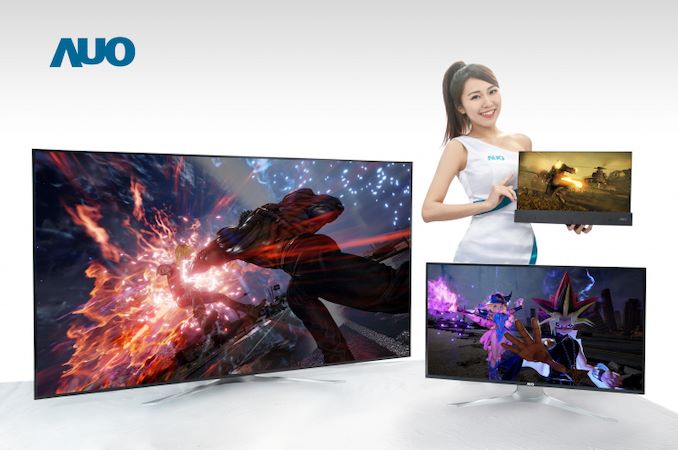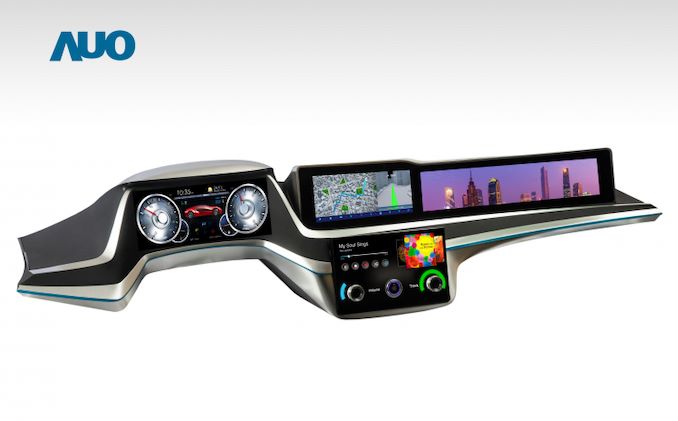AUO’s Mini LED Monitors: 32-Inch 4Kp144, 65-Inch 4Kp144, VR, & Others
by Anton Shilov on August 30, 2019 1:15 PM EST
Among other leading-edge consumer displays demonstrated by AU Optronics this week at Touch Taiwan 2019 trade show are the company’s monitors with Mini LED backlighting. The displays are intended for a variety of applications that benefit from high brightness and contrast ratios, including Ultra-HD televisions, computer displays, VR headsets, and in-car infotainment systems.
The largest Mini LED-enabled screen from AUO is a 65-Inch display featuring a 3840×2160 resolution, 2,500 nits peak brightness, a 144 Hz refresh rate, and over 1,000 local dimming zones. Officially, this one is called a ‘large size gaming display’ and could easily compete against NVIDIA’s BFGDs sold by ASUS and HP when it is available. Meanwhile, being a maker of panels, AUO cannot pre-announce actual retail products by its partners.
The somewhat smaller Mini LED offering from AUO is its 32-inch prototype featuring a 4K resolution, 1,500 nits peak brightness, a 144 Hz refresh rate, as well as over 1,000 local dimming zones. The LCD resembles ASUS’ 32-inch ProArt PA32UCX professional display introduced at CES, but has a considerably higher refresh rate and is positioned for gaming applications.
One more gaming screen from AUO featuring a Mini LED backlighting is a 17.3-inch LTPS 4K gaming display that meets VESA’s DisplayHDR 1000 (which means at least 1000 nits brightness) requirements and is designed for high-end notebooks.
Another interesting prototype with a Mini LED backlight module is AUO’s 2.9-inch LTPS display with 2,304 dimming zones as well as a whopping pixel density of 1,688 PPI. The screen promises ultimate fidelity and ultra-realistic VR experience, though it is unclear when AU Optronics will be able to ship the device commercially to interested parties.
Extending its Mini LED technology to non-gaming applications, AU Optronics has also developed a 12.3-inch LTPS curved cluster panel featuring a 750R curvature, a high resolution, 1000 nits brightness, and high contrasts. The screen is intended for vehicles, but considering how long it takes for auto industry to validate new technologies, AUO expects it to adopt this or similar displays within five years.
Based on the fact that AUO, which is one of the leading producers of LCDs on the planet, makes rather high bets on Mini LED-based backlighting, it looks like the technology certainly has a big future at least in high-end applications. What remains to be seen is when and whether this technology will get cheaper and will be used for mainstream displays.
Related Reading:
- AU Optronics's New 85-Inch 8K LCD TV with 1,024-Zone Backlighting
- ASUS Mini LED Professional Monitors Update: Available This Year
- Acer Joins Mini LED Monitor Club with Professional-Focused ConceptD CM7321K
- ASUS at CES 2019: ProArt PA32UCX 4K Monitor with 1000-Zone FALD Unveiled
Source: AUO












27 Comments
View All Comments
vladx - Friday, August 30, 2019 - link
The 17" display is a great solution since many gaming notebooks with RTX 2080 only come with crappy 1080p displays.Papaspud - Friday, August 30, 2019 - link
You don't need 4k for 17" screen, way too much heat and power to drive them, but to each his own.vladx - Friday, August 30, 2019 - link
I respectfully disagree, especially since this one has 1000 nits which is perfect for HDR gamingCharonPDX - Friday, August 30, 2019 - link
The brightness and HDR capabilities are completely separate from the resolution.I love "Retina" screen resolutions, where you can set your OS to 150-200% and have text be ultra-crisp.
But at 17", 4K is overkill even for that. 2.5K would be sufficient, 3K would be "as good as it needs to be." A 17" at 1920x1080 (or 2x "Retina" 4K) just has things too small for reasonable use. I had a 17" 1080p laptop for work, and I needed to put it at 125% or 150% to read anything. The 3200 x 1800 resolution used on some smaller Dells would (to me) be perfect on a 17" - run at 200% "1800x900 effective" resolution.
For me, the 4K sweet spot is 21-28" desktop monitors. Bigger than that, and I want more than 4K, smaller than that, and even 200% mode makes things too small. But, maybe my eyes are starting to get old...
timecop1818 - Friday, August 30, 2019 - link
> I had a 17" 1080p laptop for work, and I needed to put it at 125% or 150% to read anything.Then you're fucking blind. And, more importantly, if you had to 150% scale on a 1080p and were still able to do your "work" that clearly means whatever your workflow is, it will have no benefit from higher resolution. There are PLENTY of use cases for 4K on 17" (my current laptop is 4K @ 13, previous was 4K @ 15), and I have no issues with seeing stuff and I absolutely do appreciate higher resolution for the kind of work I do on the laptop.
Arnulf - Sunday, September 1, 2019 - link
And you are fucking rude and a self-centered cunt.Not everyone's eyesight is the same, not everyone's workflow is the same, not everyone's preferences or perception of ergonomics are the same. Just because something suits YOU that doesn't mean every manufacturer and consumer must bow to your choices.
People are different, so is the gear they buy. Try to pull your head out of your millennial self-centered arse.
akvadrako - Sunday, September 1, 2019 - link
The reason to have "overkill" is integer scaling. I use 4K at 14" with 200% scaling and display elements are just the right size. If things are too small for you, 300% is also usable. But of course it's not comparable to desktop monitors since those sit further away.patel21 - Friday, August 30, 2019 - link
I currently have 14" Laptop, but being a developer working from home, I would love a 17" laptop so that I can use it without monitor in a cafe or when I am out.A 17" Laptop has so much potential of being a productive machine with humongous battery life and best cooling. If only some company launches a 17" which would use the real estate it has to its full potential.
quorm - Friday, August 30, 2019 - link
So I take it mini LED backlighting is different from a straight up mini LED panel, like what Samsung demoed? Or are they basically the same tech?mckirkus - Friday, August 30, 2019 - link
You're thinking micro vs mini LED. Micro is the end-game, basically OLED but way brighter, less power, etc. Mini LED allows for much smaller local dimming zones which helps with things like blooming, etc.